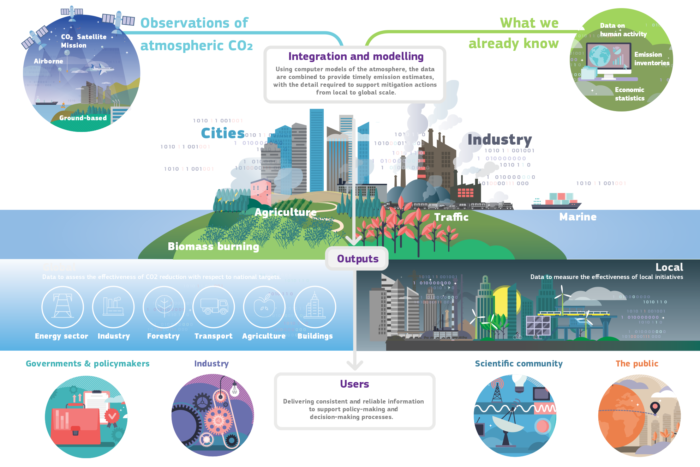
The EU’s Copernicus Atmosphere Monitoring Service (CAMS) has begun working on Europe’s first observation tool for monitoring anthropogenic CO2 emissions.
If successful, the CO2 Monitoring and Verification Support Capacity (CO2MVS) tool will enable CAMS scientists to estimate and measure emissions of carbon dioxide and methane from anthropogenic sources with unprecedented accuracy and with little delay.
The project is being developed in partnership with the European Space Agency (ESA) and the European Organisation for the Exploitation of Meteorological Satellites (EUMETSAT), who are developing a constellation of satellites dedicated to measuring carbon dioxide and methane concentrations in the atmosphere. The satellites will even be capable of looking at individual carbon dioxide and methane sources such as power plants and fossil fuel production sites. Observations from these satellites will be assimilated through sophisticated computer modeling of the Earth’s atmosphere and biosphere by CAMS scientists to be able to routinely quantify anthropogenic CO22 emissions.
A prototype of the system is currently being developed ahead of the launch of a fully operational CO2MVS in 2026. The initiative will be ready in time for the second Global Stocktake (GST) of greenhouse gas emissions set to be concluded in 2028. In the meantime, the first Global Stocktake is currently being prepared and will be finalized in 2023.
The Stocktake aims to assess the world’s collective progress toward achieving the purpose of the Paris Agreement and its long-term goals. CAMS data, especially once the CO2MVS reaches operational status, will support countries as well as regional and local authorities with their reporting obligations, but more importantly, with better understanding of the impact of their mitigation actions.
For the first Global Stocktake, CAMS is already collaborating with EU-funded research projects, such as CoCO2 and VERIFY, to provide prototype products. VERIFY has produced a first European annual synthesis, which includes CO2 emission estimates from fossil fuel and managed land from all sectors reported to UNFCCC. CoCO2 has supported the use of CAMS data to produce time series of CO2 fluxes for the AFOLU (agriculture, forestry, and other land use) sector in 10 large countries or groups of countries around the world.
Richard Engelen, deputy director of CAMS, said, “As we enter the second seven-year phase of the Copernicus program, we are excited to be launching the CO2MVS service with collaboration from our partners and to be able to improve the effectiveness of CO2 measurements like never before. Our work will continue to enable decision-making through quality data that can quantify and pinpoint anthropogenic greenhouse gas emissions for the first time. Copernicus specializes in turning science into services and we will be fully focused on delivering an observation-based CO2 monitoring capacity to help the world combat climate change.
“Since the start of the industrial revolution, we have seen carbon dioxide levels increase faster than ever before, and there is an increasing urgency to take real steps to make very significant emission reductions. By providing globally consistent and high-quality data on anthropogenic emissions we can support policymakers with this enormous challenge,” he said.


